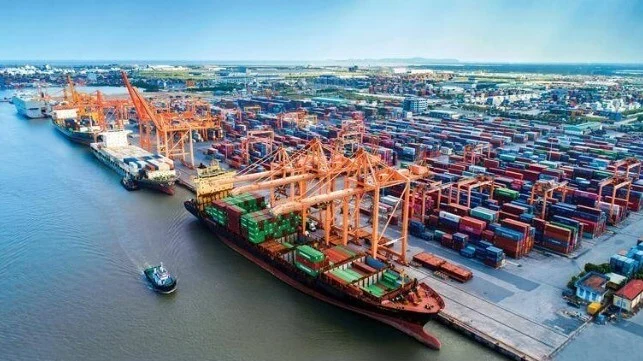Vietnam plans to build a national container shipping operation first in Asia and then global to combat supply chain disruptions (Vietnam Maritime Administration)
PUBLISHED APR 15, 2022 6:55 PM BY THE MARITIME EXECUTIVE
Vietnam is planning the launch of a national container shipping operation designed to combat the dramatic rise in freight costs and supply chain disruptions experienced during the pandemic. The Vietnam Logistics Business Association recently mapped out a plan for the development first of intra-Asia shipping operations that would later expand to international operations with the support of private capital.
The association points out that there have been many resolutions in the government on the issue of developing Vietnam’s shipping fleet, but that none previously progressed. Their new plan is in line with the government’s goal that by 2045 Vietnam will become “a developed, high-income country.” Having a fleet of containerships, they said would reduce the “huge amount of foreign currency” spent by the government on shipping as well as limit the pressure on foreign shipping lines, exposure to freight rate increases and surcharges, and provide a tool for long-term economic security for the country.
About 90 percent of Vietnam’s import and export volume is transported by sea, reaching 24 million TEU up seven percent in 2021. However, the country’s current fleet has only about a seven percent market share with the rest handed by foreign shipping lines. While Vietnam currently has 10 container shipping companies owning 48 containerships with a total capacity of 39,500 TEU, 13 of the vessels are over 25 years old and 15 of the vessels have a capacity of between 300 and 600 TEU suited only for domestic operations. Only 14 of the ships have a capacity of between 1,000 and 1,800 TEU and can run routes intra-Asia.
One of the industries that they point to as having been hard hit by the dramatic increase in freight rates and capacity constraints is wood exports. The U.S. is Vietnam’s biggest export market for wood and wooden products, accounting for nearly 60 percent of Vietnam’s total wood exports value of $14.8 billion last year. Exports to the U.S. alone rose 22 percent to $8.78 billion in 2021, but high shipping costs reduced profits.
The plan calls for the development of logistic services in Vietnam by 2025. The first phase would last three to five years and require approximately $1 billion for ships and a total investment of about $1.5 billion. It would focus on building services intra-Asia with routes to Korea, Japan, China to India, and the Middle East, which accounts for about 60 percent of the country’s import-export volume.
The first year would require a total of 14 ships with smaller ones with a capacity of 1,800 to 2,500 TEU that could dock directly at the Hai Phong Port. In the second year, they call for six similar sized ships to add routes to China and Japan, and starting in the third year more Panamax ships with a capacity of 4,000 to 5,500 TEU. In total, they call for the acquisition of at least 25 ships in the first five years, with for example a resolution not to acquire any ship over 15 years old.
The second phase of the effort to build their national shipping capability is even more ambitious, but would not be launched for at least five years while they focus on Asia. They also recognize it would require “mobilizing private capital for investments,” as well as coordinated cooperation from manufacturers, shippers, and the government.
To participate on international routes to the Americas, Europe, or around the world, they envision employing post-Panamax and large container ships with a capacity of at least 4,000 TEU and more likely between 6,000 and 11,000 TEU. The plan notes that it might even require ultra-large vessels with a capacity between 11,000 and 14,000 TEU or even 18,000 TEU.
The Vietnam Logistics Business Association considers moving forward with the plan vital to the long-term development of the country. They point to Vietnam’s experiences in the 1970s when the country was embargoed and blockaded. They note that the state bank borrowed more than $45 million to borrow, buy, and charter a fleet of 19 ships to establish foreign trade.
Reference: https://maritime-executive.com/article/vietnam-plans-1-5b-investment-to-build-national-shipping-line

